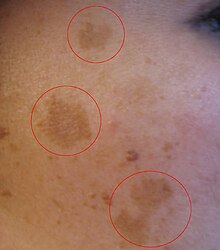User:Mr. Ibrahem/Melasma
| Melasma | |
|---|---|
| Other names | Chloasma faciei,[1] mask of pregnancy[2] |
 | |
| Melasma on the cheek | |
| Specialty | Dermatology |
| Symptoms | Areas of brown or darker skin on the face[3] |
| Usual onset | 20 to 40 yr old[4] |
| Types | Epidermal, dermal, mixed[4] |
| Risk factors | Sun exposure, genetics, pregnancy, hormonal birth control, hormone replacement therapy[3][5] |
| Diagnostic method | Based on the appearance[4] |
| Differential diagnosis | Solar lentigo, drug induced hyperpigmentation, Nevus of Ota, post inflmmatory hyperpigmentation[4] |
| Treatment | Sunscreen[6] |
| Medication | Hydroquinone, tretinoin, steroid cream[7] |
| Prognosis | Generally good[7] |
| Frequency | Common[3] |
Melasma, also known as the mask of pregnancy,[8] generally presents with areas of brown or darker skin on both sides of the face.[3][4] Most commonly it occurs on the cheeks, chin, nose, or forehead.[3] Less commonly the forearms or neck may be involved.[6]
Causes may include sun exposure, genetics, pregnancy, hormonal birth control, hormone replacement therapy (HRT), or certain medications.[3][5] Occasionally thyroid disorders are implicated.[4] Diagnosis is generally by examination of the skin.[7] Occasionally a skin biopsy may be done to rule out other potential causes.[7]
Treatment generally involves avoiding the sun and wearing sunscreen.[6] Often it will resolve on its own when the trigger is not longer present.[7] Occasionally medications such as hydroquinone, tretinoin, or steroid cream may be used.[7] A number of other medications or procedures may also be used.[4] Outcomes are generally good; however, the condition can reoccur.[7][4]
Melasma is common affecting between 1.5% and 33% of people.[3] Women are affected about 10 times more often than men.[3][5] Onset is typically in the 20s and 30s.[4] People with darker skin are more commonly affected.[5] The term "melasma" means brown skin.[4]
References[edit]
- ^ James, William; Berger, Timothy; Elston, Dirk (2005). Andrews' Diseases of the Skin: Clinical Dermatology. (10th ed.). Saunders. ISBN 0-7216-2921-0.: 854
- ^ Tunzi, M; Gray, GR (January 2007). "Common skin conditions during pregnancy". Am Fam Physician. 75 (2): 211–18. PMID 17263216.
- ^ a b c d e f g h Basit, H; Godse, KV; Al Aboud, AM (January 2020). "Melasma". PMID 29083744.
{{cite journal}}: Cite journal requires|journal=(help) - ^ a b c d e f g h i j "Melasma | DermNet NZ". www.dermnetnz.org. Retrieved 22 October 2020.
- ^ a b c d "Melasma: Who gets and causes". www.aad.org. Retrieved 22 October 2020.
- ^ a b c "Melasma: Overview". www.aad.org. Retrieved 22 October 2020.
- ^ a b c d e f g "Melasma: Diagnosis and treatment". www.aad.org. Retrieved 22 October 2020.
- ^ Tunzi, M; Gray, GR (January 2007). "Common skin conditions during pregnancy". Am Fam Physician. 75 (2): 211–18. PMID 17263216.
